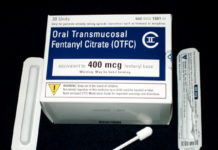that the smartest and safest course of action is taken in treatment, recovery and in life.
“The guidelines focus on alternative care and pain management, and efforts to ensure improved coordination and communications amongst prescribers,” Andersen said.
Before proposing a course of action, the physician must first determine the patient’s health history, the current problem or problems, as well as the level and duration of pain. Next, the patient must be informed of the risks of opioid treatment, which also allows the physician to determine if the pros outweigh the cons. Finally, the physician can be recommended a prescription, dosage and duration, as well as an exit strategy for the tapering and eventual discontinuation of the prescription altogether.
Once the patient has been educated on the prescribed medication, the Oregon Prescription Drug Monitoring Program (PDMP) can then help physicians, pharmacists and patients better monitor all prescriptions in one place. Pharmacies must submit prescription healthcare data for all Schedule II, III and IV substances to the Oregon PDMP where the protected health information and medical records can help healthcare providers determine and monitor the type, dose and duration of prescription medications, as well as prevent dangerous combinations of prescription drugs from being prescribed together or separately by different health care providers and programs.
The Oregon PDMP keeps people safe from their own prescriptions by acknowledging how important it is to take their medication exactly as directed. The program also helps to show how dangerous the non-medical use of prescription drugs is.
The 2013 and 2014 National Survey on Drug Use and Health found that 50 percent of opioid-related issues in the state originated from people who received free opioids from a friend or family member. This monitoring program has potential to educate people in places like Oregon into better health habits for themselves as well as unsuspecting friends or family.
The final step to eliminate the variety of harm caused by opioid use and misuse is to help those who are currently using, misusing, addicted to or suffering from withdrawals or opioid use disorder. Opioid addicts can be anyone anywhere, and the Oregon Health Authority is striving to make programs, doctors, facilities and treatments more accessible to all.
Medication-Assisted Treatment (MAT) combines behavioral therapy with the use of stabilizing and symptom-relieving medications such as buprenorphine, methadone, naltrexone and suboxone. The combination of addressing both the physical symptoms as well as the underlying emotional issues makes MAT highly successful in helping the patient transition into a drug-free life as well as helping them improve social functioning as they recover.
The Oregon Health Authority’s goal is to educate people about the availability, value and success of the Oregon Opioid Prescribing Guidelines, the Oregon PDMP, and MAT for those suffering from addiction and dependency from medical and non-medical prescribed opioids.
“The Oregon Health Authority is confident that the opioid problem is reacting well thanks to increasing enrollment in the PDMP,” Andersen said.















